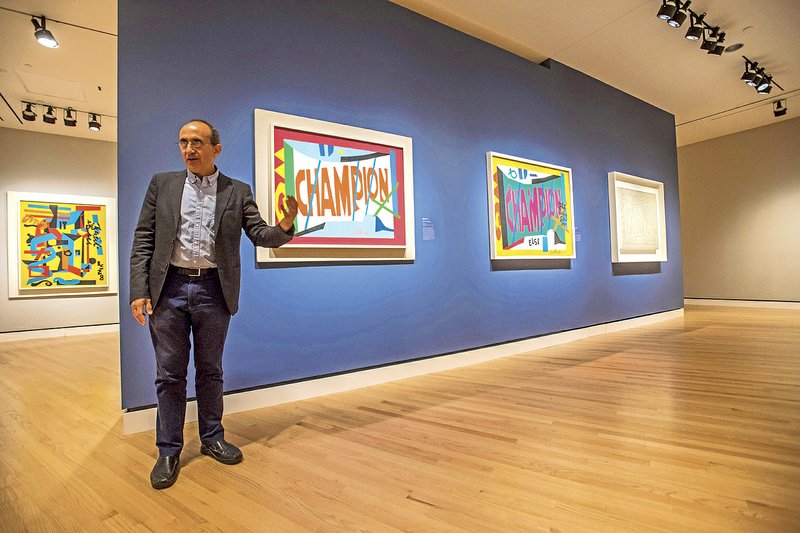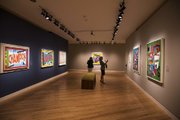Crystal Bridges Museum of American Art is taking visitors on a vibrant journey through artist Stuart Davis' life in a new exhibition titled "Stuart Davis: In Full Swing."
The exhibition -- organized by the National Gallery of Art in Washington, D.C., and the Whitney Museum of American Art in New York -- consists of 86 works from the Philadelphia-born painter.
It's the first major exhibition in more than 20 years dedicated to Davis, who is considered a key figure in the development of American modern art with a career that spanned roughly six decades.
"It just blows my mind when you think about what he lived through," Crystal Bridges curator Margi Conrads said during a media preview Thursday. "He saw the advent of the car. He saw the advent of the spaceship and a whole lot happens in between. He lived through a couple of world wars, the [Great] Depression and he was active as a painter from his teenage years."
Davis' 1912 Self-Portrait, a piece from Crystal Bridges' permanent collection, serves as one of the first impressions of the exhibition. But the majority of the works center on Davis' life and career from the 1920s until his death in 1964, showcasing a unique style that was influenced by his first art teacher, Robert Henri, and European modernists like Fernand Leger and Henri Matisse.
His love of jazz, interest in everyday city life and fascination with consumer products and advertisements are all recurring themes in Davis' work on display at Crystal Bridges. So, too, are his fondness for American poet Walt Whitman and the use of colors, shapes, words, lines and symbols.
"If there's one sort of big takeaway for Davis, it's putting together this real interest in the American scene and spirit with all of the experiments of European modernism, French art in particular," said National Gallery of Art curator Harry Cooper, who co-organized the traveling exhibition with Whitney Museum of American Art curator Barbara Haskell.
The artist often worked in series, and the exhibition includes paintings from Davis' Egg Beater series, which Cooper said may have been his greatest collection. The artist said he nailed an eggbeater, an electric fan and a rubber glove to a tabletop and painted it for a year.
While there's an abstract feel to the pastel-colored pieces, Cooper and Conrads cautioned that Davis was not an abstract artist. For that matter, Conrads said Davis doesn't fit into any art movement of the time. Instead, she said she believes he consistently displayed a style that couldn't be put "into a box."
"Davis' art does not fit into any of those -isms or special pockets," Conrads said. "He really is a combination of everything, and that makes him very unique."
That is evident in a range of works that include Lucky Strike (1921), Rue de l'Echaude (1928), New York Mural (1932) and The Mellow Pad (1945-51), which was a six-year project. The Mellow Pad was completed at the beginning of a decade in which Conrads said Davis really "hit his stride in a new way," producing bigger, bolder paintings like Little Giant Still Life (1950).
Music, words and color continued to be prominent in Davis' work even in the final years of his life, when Cooper said he restricted his palette to black, white, red green and orange.
The exhibition ends with Davis' final, unfinished canvas Fin. The painting was on the artist's easel when he died in 1964 at the age of 71. The colorful piece, which includes the French word for "the end" in the upper left side, is still lined with strips of masking tape.
"He leaves us with this, with us always wondering where would he have gone next?" Conrads said.
Some of Davis' work in the exhibition will be recognizable to Crystal Bridges regulars. Five pieces featured are part of the museum's permanent collection, including Self Portrait, the colorful Punch Card Flutter No. 3 (1963) and Rue de l'Echaude (1928) created during his influential time in France.
Cooper said it took five years to put together "Stuart Davis: In Full Swing," pulling work from museums and private collections. Crystal Bridges is the final stop. The exhibition previously appeared at the Whitney Museum, the National Gallery of Art and the de Young Museum in San Francisco.
The exhibition is set to a jazz soundtrack, which can be heard throughout the galleries.
It also features a 1950s-style sitting area -- complete with a copy of Time magazine that features a story on Davis -- put together with the help of interior designer Chris Goddard.
Admission for "In Full Swing" is $8 for adults, or $12 combined with "Chihuly: In the Forest." There is no cost for museum members and youth ages 18 and under. The exhibit opens to the public on Saturday and closes Jan. 1.
"One thing that's very important about Davis is really seeing his step-by-step development," Cooper said. "These galleries follow a path. There's only one way you can go and it leads you through his career."
Business on 09/15/2017


